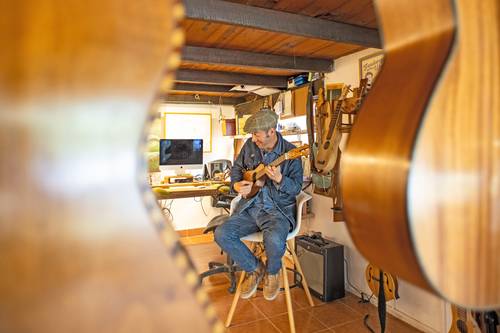Son de Madera has been in business for 30 years creative resistance, with pleasure of playing for the people
Son de Madera was clear about it from the beginning. They would not pursue the big stages or popularity, not even for millions of pesos; Their mission would be to place the son jarocho on the musical map, and they would do so with verses inspired by Cuban and Latin American poetry, and including instruments such as double bass, with impeccable executions.
30 years after the formation of this ensemble, Ramón Gutiérrez Hernández, originally from Tres Zapotes and living in Xalapa, Veracruz, receives The Conference in his house, a house with wooden paneling, located on a cobblestone street, very close to Los Berros park. The topic of the interview: what some specialists call the classical music of Veracruz.
From there, Ramón Gutiérrez said that the current musical landscape is nourished by abundant son jarocho groups, but three decades ago, when he and other musicians of the time, such as Laura Rebolloso and Tereso Vega, began to strum their jaranas and sing their coplas , this musical genre was at risk of disappearing.
At that time, all the kids listened to rock, and one was like a bean in the rice, but after 30 years of Son de Madera and the work of other groups such as Mono Blanco, Los Leones de la Sierra de Xichú or Los Camperos de Valle, that has changed, son jarocho has a space in the culture in Veracruz, in Mexico.
Son de Madera arose from playing with the idea of being a musical ensemble through which its young members could follow in the footsteps of soneros like Arcadio Hidalgo, a member of Mono Blanco. They were named by Antonio García de León, historian and musician, who dedicated years to documenting son jarocho.
Talking to Ramón Gutiérrez is like opening a musical encyclopedia, there is no shortage of references to John McLaughlin, Roger Waters, Wes Montgomery and Jethro Tull. Nor does he escape mention of the Cuban and Latin American poetry to which he is fond.
“What is the contribution of Son de Madera in these 30 years? For us, music meant being part of a tradition and convincing people that this tradition was important, that it did not start here, but that it came from Africa, from the Arabs, that came here to mix with our culture.
When I played son jarocho as a young man, it was about convincing people that it was important not only because of tradition, because it is folk music, but because it has a message, depth, that frees the spirit. Son de Madera convinced people that this music is important.
Audience and followers of Son de Madera cover a wide spectrum, ranging from son fans; from academics and activists to human rights defenders. They agree that they found in their songs a particular cadence, certain literary figures in their verses and themes such as natural wealth and miscegenation that distinguished them from other son groups.
Ramón Gutiérrez said that in an environment where strong, barbaric son predominated – with allusions to peasant life and the cowboy man –, he conceived Son de Madera as an ensemble that could recreate other landscapes, other atmospheres, as they do in their songs. At the sea o Dawn.
He said that to achieve this goal, he let himself be guided by Cuban and Latin American poetry, by Nicolás Guillén and Jaime Sabines.
“At that time son was seen as a picaresque genre. It was said that the jarochos were funny, but I was looking for that poetry, those ancient forms of son jarocho. I wanted to say: ‘you have such killer, beautiful eyes that they don’t deserve to cry, but rather to cry for them,’” he added.
Ramón Gutiérrez explained that as a sonero he is always in favor of important things happening for human beings, “and when you see characters like Roger Waters showing solidarity with the Palestinian people, you connect with him, and think: ‘that also means being musician; If you have that form of expression and can reach more people, you cannot remain silent in the face of injustice.’”
Mixture and diversity
Son de Madera has sung about miscegenation, cultural diversity and corn.
When I was young, it was a problem to accept that you were not white, that you had thick lips, a wide nose, Chinese hair. There was a need to deny that one was half Afro, half Indian. With our songs we try to claim diversity, to feel proud of our Mexicanness.
In Ramón Gutiérrez’s house there are, in addition to half a dozen jaranas of various styles, guitars, a painting of a mermaid, a board with the class schedule for Neftalí Rodríguez’s online school, and in one of the bureaus, on a cloth mat, the Grammy for best Latin album of 2022. Its owner does not like to show it off, insists that he I just wanted to show that son jarocho is not out of tune
.
Son de Madera celebrates three decades with seven albums under their belt, among which stand out They are made of wood (1996), The orchestras of the day (2004) y Caribbean syncopated sea (2014). Ramón Gutiérrez celebrates the anniversary with a personal album: imaginary loves, which includes songs like The southern conga, Imaginary loves y The fandangueros of the world.
We continue in creative resistance, in resistance that has to do with spiritual peace, with the pleasure of continuing to play our instruments, and to continue enjoying playing in spaces like El CaSon, in the port of Veracruz, for the people of the town.
expressed Ramón Gutiérrez.
The members of Son de Madera are Óscar Terán, Tereso Vega, Pablo Emiliano Castellanos, Ramón Gutiérrez, Santiago Gutiérrez Rebolloso, Lucía Gutiérrez Rebolloso, Cecilia Gómez, María Conchita Patraca and Melanie Smith.
